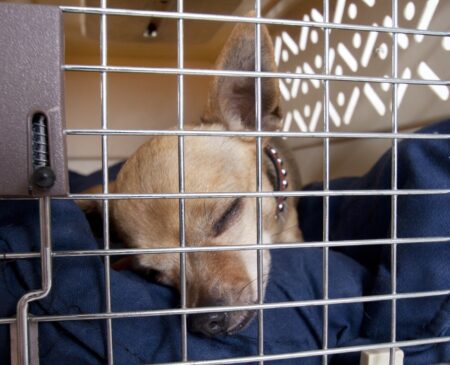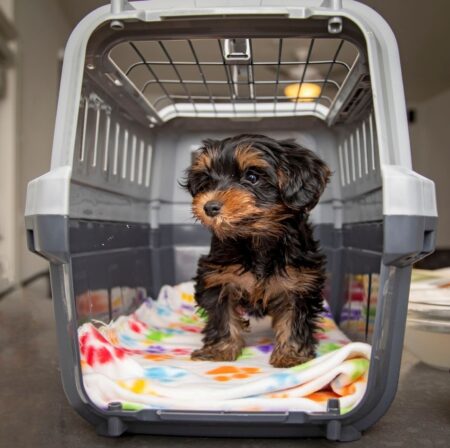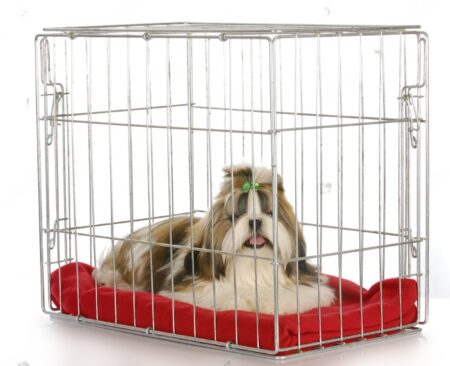How To Stop Puppy From Crying In Crate
Crate training is a great way to help your furry friend adjust to being in a safe, secure space. However, it can be stressful to have your pup cry in their kennel when they are first getting used to being there. Fortunately, there are many things you can do to help reduce your pup’s distress and help them become comfortable in their crate. The following are a few tips to help you stop your puppy from crying in their crate.
How To Stop Puppy From Crying In Crate
Crate training is an important part of housetraining and can make your life much easier. But when your pup whines or cries in the crate, he may be telling you that he’s uncomfortable or scared. Here are some tips to stop him from crying in the crate:
- Make sure the crate is comfortable and inviting. Add a comfortable bed and some toys for the pup to play with.
- Give your pup some time in the crate without closing the door. This will help him get used to it and not fear it.
- If possible, put the crate in a good spot where he can observe what’s happening around him.
- Make sure to take him out of the crate often. Regular breaks will help him from feeling trapped and lonely.
- Don’t scold your pup for crying in the crate. This will only make him more anxious and scared about going back in.
- Reward your pup with toys and treats when he’s tolerant and quiet in the crate.
These tips will help your pup to feel more comfortable in the crate and will make crate training much easier. Always remember to be patient, consistent, and loving when training your pup. Over time, he’ll learn to become calmer and quieter in the crate.
Will Your Puppy Ever Like His Crate?
Yes! Most puppies eventually come to enjoy their crates. It is a place where they can feel secure and know that they won’t be disturbed. However, they need to be gradually introduced to it and must be taught that it is a positive place and not a place of punishment. With a little patience and lots of rewards, it is very likely that your puppy will begin to love his crate soon!
Should I Crate Train My Puppy?
Yes, crate training your puppy is beneficial, as it helps to get them used to being alone, provides a sense of security, and can help with potty training and destructive behaviors.
How do I stop my puppy from crying and excessively barking in her crate?
- Provide your puppy with positive reinforcement. Give your puppy treats, toys, and praise when he or she is calm in the crate.
- Ensure that the crate is the right size for your puppy. A crate that is too small can become a source of anxiety.
- Create a calm environment before putting your puppy into the crate. This may include turning off the television, reducing the amount of noise, and dimming the lights.
- Give your puppy something to chew on or a puzzle toy while they are in the crate. This will give them something to do and help distract them from barking or crying.
- Make sure your puppy has had plenty of exercise and a bathroom break before you put them in the crate. This can help reduce the need to vocalize.
- When you first start crate training, make sure to give your puppy short periods of time in the crate. Gradually increase the lengths of time, and always provide your puppy with plenty of breaks.
- Offer a treat or toy when you put them into the crate. This will help your puppy learn to look forward to going in the crate and associate it with good experiences.
- If your puppy is crying or barking in the crate, do not respond to it. Any attention, positive or negative, will reinforce the behavior. Instead, wait until your puppy is quiet before you provide rewards.
Where Should I Place My Crate?
A Crate can be placed in any secure spot of your home, such as in a corner of a room or near the window. Avoid placing the crate in high-traffic areas like doorways or hallways, as well as near windows or radiators. It should also be placed in an area that is quiet and relaxed, and far away from any outside noise that might disturb your pup. Finally, the crate should be large enough for the pet to comfortably move around and stretch while inside.
How Long Should I Let My Puppy Cry In The Crate Before I Take Action?
It is recommended to wait at least 10 minutes before taking action when a puppy is crying in the crate. There is no set time limit, but if the crying continues for more than 20 minutes, it may be time to assess why the puppy is crying. Additional assessment may be necessary to determine if the puppy is upset, stressed, or has a medical issue that needs to be addressed.
Puppy Screaming In Crate For Hours
If your puppy is screaming in his crate for hours, it’s important to determine why and address the issue immediately. Common causes of long-term crate whining can range from boredom or loneliness to health issues or distress due to being away from familiar surroundings. Make sure that your puppy is provided with chew toys, access to water, and regular potty breaks. If the problem continues, consider taking your puppy to the veterinarian to rule out any medical issues.
Puppy Cries In Crate When I Leave The Room
When puppies are left home alone they may experience separation anxiety, which can lead to them crying in crates when you leave the room. Separation anxiety is a common issue among puppies and younger dogs and usually stems from them not having proper socialization or inadequate attention to their own emotional needs. It’s important to give your pup plenty of attention when you’re not home, as well as provide them with interactive toys that will mentally stimulate them. Additionally, getting plenty of exercise with your pup will help them to be able to relax when you’re gone, and slowly increase the time that you spend away as they get older and more used to it.
SEE ALSO: Can Dogs Get Headaches?
Why Do Puppies Whine in Their Crates?
Puppies can whine in their crates for a variety of reasons. It may be because they’re still adjusting to the new environment and feel scared or anxious. As young puppies may not have the ability to control their bladders for long periods of time, and they may start whining if they need to go to the bathroom. This is a way for them to communicate their need to their owners. Additionally, puppies have a natural instinct to be close to their family, so they may whine due to loneliness or separation anxiety if they are away from their owners for too long. Lastly, puppies may whine if they are in uncomfortable or unfamiliar surroundings. If you think this is the case, it may be a good idea to introduce them to other objects in the space to make them more at ease.
How To Respond To Typical Puppy Whining Scenarios
Puppy whining can be a difficult problem to address, and the best way to respond to any whining situation depends on the specific circumstances. Generally speaking, it is important to remember to remain calm and consistent.
If your puppy is whining during play:
Avoid giving in to the whining behavior and providing attention. Instead, gently redirect your puppy’s attention back to the desired activity (e.g., give them a different toy to chew on), and reward them with praise when they successfully move on.
If your puppy is whining when left alone:
Try to gradually get your puppy accustomed to being alone by taking small steps–start with short periods away from your pup and slowly increase the length of time until your puppy is able to handle the amount of time needed. During this process, provide your puppy with a special toy or treat to keep him occupied and comfortable.
If your puppy is whining when wanting something:
Respond by making it clear that the only response to the whining is to remain consistent and not give in. Instead, give your puppy verbal cues to stay or sit, and reward them with treats or attention when they display the desired behavior. If the whining persists, you may need to take a short break from the activity and try again later.
How to Get a Puppy to Stop Whining in His Crate
- Make sure the puppy has plenty of exercises and is worn out when it’s time to go into the crate. A tired puppy is much less likely to whine.
- Give your puppy a toy or chew bone that will keep it distracted while in the crate.
- Reduce the crate’s exposure to noise and chaos, such as people talking or loud music.
- Place a blanket or pillow in the crate to make the puppy feel more comfortable.
- Ensure that the puppy is receiving adequate potty breaks when taken out of the crate. Otherwise, the puppy may feel the need to whine when confined to the crate for too long.
- Speak to the puppy in a soothing voice to reassure him that everything will be all right.
- If the whining persists, try ignoring it – this could teach the puppy that whining does not produce results.
- If the whining persists, remove the puppy from the crate and take him to a calm, quiet place to help relax him before attempting to place him in the crate again.
Puppy Crying And Whining in Crate: When to Worry
When it comes to a puppy crying and whining in its crate, there are certain situations that might need extra attention. If the puppy is whimpering or crying nonstop for more than an hour, it may be in distress and need immediate assistance from its owner. A puppy may also be crying in its crate because it is feeling sick or anxious, so it is important to pay close attention to the environment and the puppy’s behavior for any signs of discomfort or distress. If the puppy is not getting proper physical activity, socialization, or potty breaks, these could also be causes of distress. If there is any concern for a puppy and its well-being, it is best to contact a veterinarian for professional advice and assistance.
Should You Close A Puppy Crate At Night?
It depends on the age and stage of your puppy. Puppies who are teething and are very young may find comfort in having their crate closed during the night. On the other hand, a puppy or adult dog who is crate trained and has been for some time may be comfortable sleeping with the crate open. If you’re not sure what is best for your pup, consult with your veterinarian.
What If My Puppy Won’t Stop Barking In His Crate?
There are a few tactics to help curb excessive barking in the crate. First, establish early on that the crate is a safe and comfortable place for your puppy by gradually introducing them to the crate and not forcing them into it. Then, when your pup starts barking in the crate, distract them away from this behavior by giving them a toy or treat, or trying to redirect their attention somewhere else. If the above tactics fail, you may want to look into getting a crate cover that drapes over the top of the crate to help diminish sound and create a den-like atmosphere for your pup. Finally, it is important to exercise your pup to help alleviate anxiety and allow them to release their energy.
FAQ
Q. Do I let my puppy cry in the crate?
A. No, you should not let your puppy cry in the crate. Crying can create a negative association with the crate, making it harder for your pup to learn to love being in the crate. Instead, try rewarding positive behaviors, such as entering or sleeping in the crate, and providing desirable treats and toys in the crate for your pup to explore.
Q. How long do I let the puppy cry in a crate?
A. It is important to keep in mind that puppies become accustomed to their environment and need time to adjust to their crate. The amount of time a puppy should be allowed to cry in a crate will depend on age and how much distress the puppy is showing. Generally, new puppies should not be left to cry in a crate for more than five minutes, while an older puppy may cry for up to 10-15 minutes before being comforted. If the puppy is still showing signs of distress after this time, it is important to help the puppy adjust by providing reassurance and support.
Q. Is Crate Training Even Necessary?
A. Crate training is a valuable tool used by pet owners as a way to provide a safe space for their furry friend, limit destructive behaviors, and facilitate house training. It is not necessary for all pets, but when used properly, it can be a safe and helpful option for many animals.
SEE ALSO: How To Stop A Dog From Digging
Conclusion
Dogs can become anxious and stressed in their crates if they are not given proper attention and training. If you are having trouble getting your puppy to stop crying in his crate, there are several things that you can try. First, start by ensuring that your pup’s crate is comfortable, with plenty of room and soft bedding. Second, provide your pup with treats for being inside his crate, and be sure to spend quality time inside with him. Third, provide plenty of physical and mental enrichment activities, like toys and puzzle games, and make sure he is getting adequate exercise. Finally, you can turn to specially formulated calming aids and diffusers, or look into crate training for guidance. With patience and consistency, you should be able to successfully get your puppy to stop crying in his crate.


